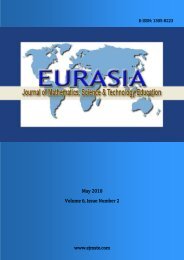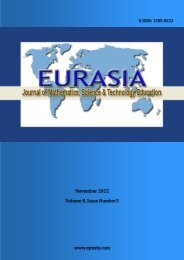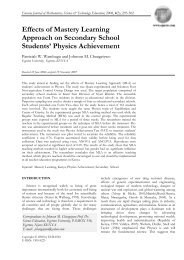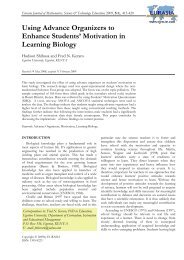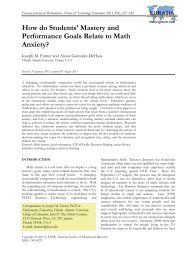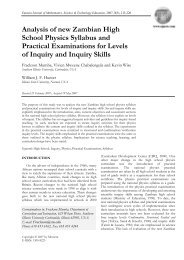Teaching of Mathematical Modeling and Problem Solving
Teaching of Mathematical Modeling and Problem Solving
Teaching of Mathematical Modeling and Problem Solving
Create successful ePaper yourself
Turn your PDF publications into a flip-book with our unique Google optimized e-Paper software.
Ö. D. Temur<br />
The prospective teachers stated that modeling during<br />
problem solving contributed to peer learning <strong>and</strong> made<br />
the students more motivated <strong>and</strong> enthusiatic during the<br />
problem solving process. They also added that the<br />
modeling process made the problem solving process<br />
more concrete <strong>and</strong> enjoyable.Reys, Lindquist, Lambdin<br />
<strong>and</strong> Smith (2009) emphasize that in oder to organize<br />
mathematical ideas, language is an important tool <strong>and</strong><br />
that speaking, writing, doing explanations, joining<br />
discussions about mathematical ideas contribute to<br />
students’ experience. They also add that helping<br />
students communicate by using tables, graphs,<br />
estimation, drawings <strong>and</strong> symbols fascilitates <strong>and</strong><br />
improve their learning. During modeling process,<br />
students frequently speak loudly, share <strong>and</strong> present their<br />
solutions to the class.<strong>Modeling</strong> is such a process that<br />
accelerates the communication process <strong>of</strong> students,<br />
increases their attention to focusing on the way to the<br />
result <strong>and</strong> enables focusing. Discussions in mathematics<br />
classes are necessary to achieve individual underst<strong>and</strong>ing<br />
<strong>and</strong> to share the solutions <strong>and</strong> interpretations (NCTM,<br />
2000).<br />
In their expressions, it is remarkable that the<br />
prospective teachers considered their own solutions <strong>and</strong><br />
drawings <strong>and</strong> schemes for those solutions when<br />
modeling was mentioned. I tried to simplify the<br />
modeling <strong>and</strong> analyze it for them to do the modeling<br />
successfully. I explained the problem step by step by<br />
making sense <strong>of</strong> the variables in the question. I<br />
rearranged the problem by determining what was given<br />
<strong>and</strong> what was wanted in the problem. I drew an<br />
explanatory table on the board (20). The prospective<br />
teacher, seeing him/herself in the center <strong>of</strong> the course<br />
in which, in fact, student activities <strong>and</strong> discovery<br />
processes should have been the case, used the words “I<br />
analyzed, explained, rearranged” <strong>and</strong> revealed how they<br />
reflected their own analysis process to the classroom<br />
environment about how they perceived modeling. Also,<br />
the fact that some students formed a model other than<br />
their teacher used <strong>and</strong> therefore approached to the<br />
question with a different perspective amazed the<br />
prospective teachers. Different mathematical<br />
presentations lead to different perspectives. Two<br />
different types can be mentioned in mathematics<br />
presentation: the first being using graphs, diagrams <strong>and</strong><br />
tables while the second beingthe teacher depended<br />
mainly on words <strong>and</strong> explanations. <strong>Mathematical</strong><br />
concepts can be given via both presentations, but the<br />
latter reflects one’s own experience <strong>and</strong> mathematical<br />
concepts in store; however, relying mainly on<br />
presentations supported by visual aids is crucial in<br />
mathematics teaching (Barmby, Bilsborough, Harries<br />
<strong>and</strong> Higgins, 2009). During mathematics teaching<br />
process, meanings <strong>of</strong> the words, explanations <strong>and</strong><br />
symbols used by the teacher should be talked about <strong>and</strong><br />
discussed in the classroom (Dickson, Brown <strong>and</strong><br />
Gibson, 1984).<br />
The prospective teachers stated that some <strong>of</strong> their<br />
students live the experience <strong>of</strong> solving problems by<br />
modeling for the first time. The students stated that in<br />
their previous mathematics lessons, they had solved<br />
more problems <strong>and</strong> in that lesson they solved fewer<br />
problems but using tools <strong>and</strong> modeling they understood<br />
the solution process better. Van De Walle, Karp <strong>and</strong><br />
Williams (2010) state that at this point, students will<br />
develop their own learning strategies <strong>and</strong> solution<br />
processes if their teachers choose high quality problems<br />
<strong>and</strong> provide them with rich learning environment.<br />
It is crucial to provide such environment to students<br />
that will encourage them to solve problems. Students<br />
should be feeling themselves free <strong>and</strong> comfortable in<br />
revealing all their ideas. They should be able to take<br />
risks, try new strategies <strong>and</strong> do different explanations.<br />
Even if their explanations aren’t correct, they should be<br />
discussed in the classroom, reexplained <strong>and</strong> used as a<br />
learning tool. In this way, they will be able to evaluate<br />
their steps <strong>and</strong> results (Sherman, Richardson, Yard,<br />
2005 ). In this research, the prospective teachers, as<br />
frequently seen in their expressions like “After we<br />
started modeling, the reactions <strong>of</strong> the students amazed<br />
me <strong>and</strong> made me happy. As we continued, they said<br />
among themselves “aa yes, right, how did I make this<br />
mistake...”, realised that, as an important component <strong>of</strong><br />
modeling, explanation helped the students make better<br />
sense <strong>of</strong> what was given <strong>and</strong> wanted <strong>and</strong> achieve<br />
correlational underst<strong>and</strong>ing during problem solving.<br />
Analyzing the modeling samples <strong>of</strong> the prospective<br />
teachers in practice classes, it is seen that the students<br />
used various figures, schemes <strong>and</strong> even real objects.<br />
Whether routine or nonroutine problem situations, all<br />
the students’ modelings were analyzed <strong>and</strong> it was found<br />
that they were appropriate for the solution process. As<br />
can be understood from the expression “Prior to<br />
modeling, the question wasn’t been able to be answered<br />
<strong>and</strong> the classroom started get disturbed. It was clear that<br />
it was time for modeling. The students got their<br />
modeling clay <strong>and</strong> mushrooms. After reading the<br />
question again <strong>and</strong> doing the necessary analysis, we did<br />
the modeling <strong>of</strong> sorting the necessary out <strong>of</strong><br />
unnecessary <strong>and</strong> subtraction-multiplication-addition<br />
operations with mushrooms <strong>and</strong> spots (28)”, the<br />
prospective teachers stated that most <strong>of</strong> the students<br />
didn’t have any difficulties in the modeling process<br />
<strong>and</strong>solved the problems enthusiatically. This experience<br />
in mathematics teaching practices is crucial in that they<br />
saw the relation between theory <strong>and</strong> practice <strong>and</strong> they<br />
gained the pr<strong>of</strong>iciency for future encounters with similar<br />
situations.<br />
With their expressions “The problem was simplified<br />
in modeling stage during which the students started to<br />
underst<strong>and</strong> better. They drew models for half <strong>and</strong><br />
90 © 2012 EURASIA, Eurasia J. Math. Sci. & Tech. Ed., 8(2), 83-93



